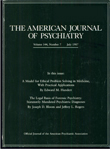Effect of diagnostic criteria on the ratio of male to female schizophrenic patients
Abstract
Contrary to earlier epidemiological data, recent evidence points to a significantly greater proportion of men than women among schizophrenic patients diagnosed by current restrictive criteria. In this study, the authors analyzed the effect of using six different diagnostic systems (varying in their stringency) on the male to female ratio of schizophrenia among 387 inpatients. Diagnostic criteria representing a broad conceptualization of schizophrenia, such as the New Haven Schizophrenia Index, consistently yielded equal rates of schizophrenia among men and women. Those diagnostic systems representing more stringently defined schizophrenia, such as the Research Diagnostic Criteria, consistently yielded a male to female ratio significantly greater than the male to female ratio of the total sample.
Access content
To read the fulltext, please use one of the options below to sign in or purchase access.- Personal login
- Institutional Login
- Sign in via OpenAthens
- Register for access
-
Please login/register if you wish to pair your device and check access availability.
Not a subscriber?
PsychiatryOnline subscription options offer access to the DSM-5 library, books, journals, CME, and patient resources. This all-in-one virtual library provides psychiatrists and mental health professionals with key resources for diagnosis, treatment, research, and professional development.
Need more help? PsychiatryOnline Customer Service may be reached by emailing [email protected] or by calling 800-368-5777 (in the U.S.) or 703-907-7322 (outside the U.S.).



